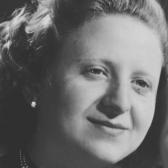
-
Learn More about Fanny
Fanny Aizenberg was born into an Orthodox family in Lodz, Poland. Fanny and her family moved to Brussels, Belgium when she was a young child. One of three daughters, Fanny’s family was very active within their community. Her father was employed by the Yiddish Gemeinde (Jewish community organizations) of Brussels that coordinated Jewish activities, ritual slaughter, and Jewish burials. Fanny earned a degree in art and design before WWII broke out and found employment among designers creating clothing for the Royal House of Belgium. In May of 1938, Fanny married Jacques, a violinist for silent films and a tailor. In March of the following year, Fanny gave birth to their daughter, Josiane.
Germany invaded Belgium in May 1940. The clinics where Fanny took one year old Josiane for medical care no longer admitted Jews. Jewish physicians were dismissed from their positions, Jewish children were not permitted to attend school, and Jews were forbidden to work. All Jews had to register for rations as well as purchase and wear a yellow star.
Fanny became involved in the Belgian Resistance movement by hiding refugees in her attic. Through her involvement in the resistance movement, Fanny arranged a hiding place for Josiane. Fanny and her mother spent time in multiple hiding places until they were discovered and arrested. She and her mother were beaten by the Gestapo and taken to the Mechelen (Malines) transit camp. After ten days in Mechelen, Fanny and her mother, along with all other prisoners, were deported to the concentration camp Auschwitz. Of the one hundred and ten persons packed into a single train car along with Fanny, forty survived the three day journey.
Upon arrival in Auschwitz, Fanny and her mother were placed in separate lines. She never saw her mother again. During one of the selections Fanny was chosen for medical experiments. Fanny found encouragement from a group of six women who helped her to endure beatings, forced labor in a grenade factory, and the many other horrors of Auschwitz. Speaking with these women of her hope to be reunited with her child helped Fanny survive.
On January 17, 1945, Auschwitz was evacuated by the Nazis, and Fanny was forced on a death march. After four months, Fanny and the other prisoners were liberated near the Elbe River by the Russians in April of 1945. The Russians took the prisoners to a makeshift hospital where they were fed and cared for. Ten days after her liberation a delegation from the Red Cross brought Fanny back to Belgium where she was reunited both with Josiane and Jacques. Fanny lived in the Greater Washington, DC area and volunteered at the United States Holocaust Memorial Museum along with her daughter Josiane Traum (Aizenberg), and Alfred Traum, Josiane’s husband.










